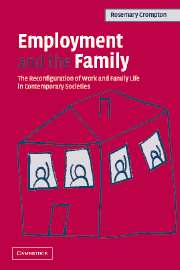Book contents
- Frontmatter
- Contents
- Preface
- 1 Understanding change in employment, family and gender relations
- 2 Caring and working
- 3 Women, men, organisations and careers
- 4 Work–life articulation, working hours and work–life policies
- 5 States, families and work–life articulation
- 6 Households, domestic work, market work and happiness
- 7 Class, family choices and women's employment
- 8 Conclusions
- Appendix A Additional ISSP Family 2002 questions
- Appendix B Joseph Rowntree Foundation (JRF) interviewees cited
- Bibliography
- Index
6 - Households, domestic work, market work and happiness
Published online by Cambridge University Press: 22 September 2009
- Frontmatter
- Contents
- Preface
- 1 Understanding change in employment, family and gender relations
- 2 Caring and working
- 3 Women, men, organisations and careers
- 4 Work–life articulation, working hours and work–life policies
- 5 States, families and work–life articulation
- 6 Households, domestic work, market work and happiness
- 7 Class, family choices and women's employment
- 8 Conclusions
- Appendix A Additional ISSP Family 2002 questions
- Appendix B Joseph Rowntree Foundation (JRF) interviewees cited
- Bibliography
- Index
Summary
The ‘breadwinner’ model of the articulation of employment and family life assigned women to domestic work and the family. As described in previous chapters, the naturalism of this gender arrangement or division of labour was extensively challenged by second-wave feminism. Nevertheless, an essentialist ideology of domesticity, that assigns domestic responsibilities and self-sacrificing motherhood to women, has proved to be remarkably persistent (Williams 2000). A major feminist objective that was articulated during the 1960s, 1970s and 1980s was to encourage men to play a greater part in domestic work and childcare – summed up in the popular slogan of the time: ‘the personal is political’. As with women's involvement in market work, so men's involvement in domestic work has also changed. However, most of the narrowing of the gender gap in respect of domestic work has come about because of women's declining involvement, rather than men's increased participation, in domestic work. In this chapter, recent trends in time use and the domestic division of labour will be examined cross-nationally. A number of other relevant issues will also be addressed, including the impact of variations in the domestic division of labour on work–life conflict. We will return in particular to the case of France, where, as described in Chapter 5, levels of work–life conflict are relatively high despite good state supports for employed mothers and non-excessive working hours. We will also examine the impact of domestic traditionalism on general and family happiness, particularly for women.
- Type
- Chapter
- Information
- Employment and the FamilyThe Reconfiguration of Work and Family Life in Contemporary Societies, pp. 139 - 162Publisher: Cambridge University PressPrint publication year: 2006

